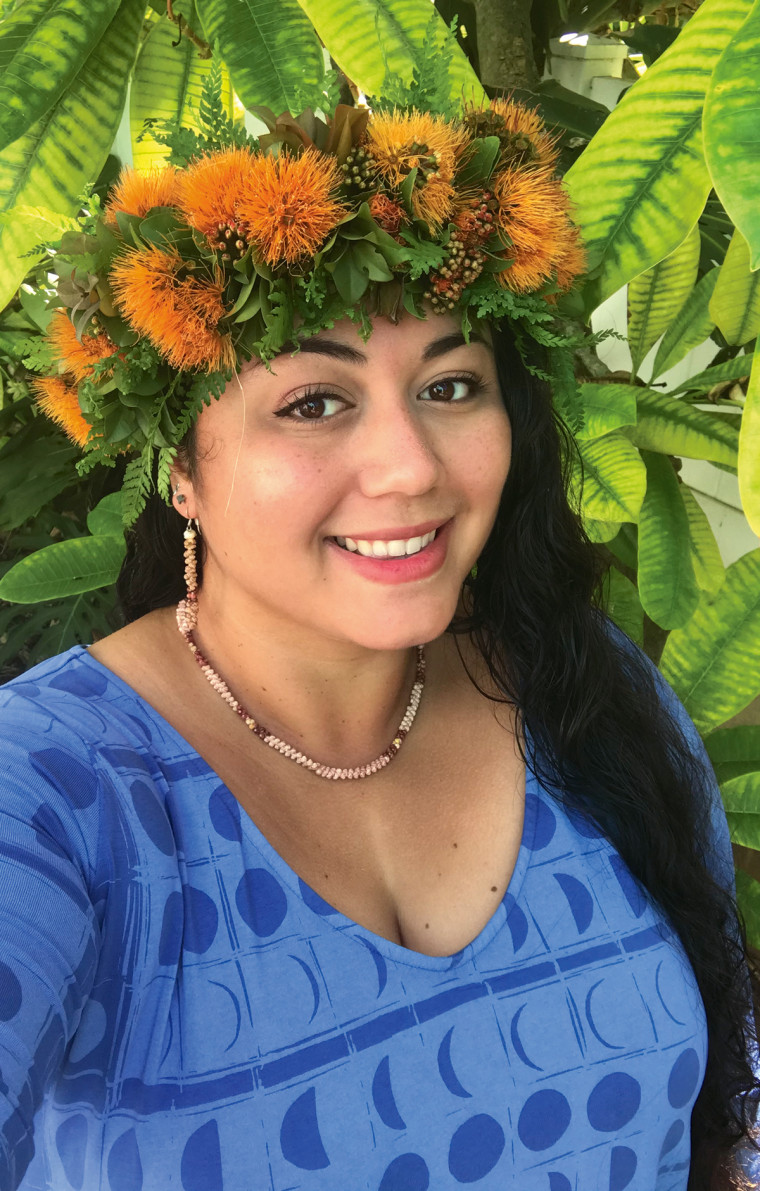Reclaiming the Indigenous Experience in the Classroom
Brigitte Ululani Russo BA ’15, a secondary teacher in Hawai‘i,is committed to integrating Indigenous knowledge into the curriculum.
Open gallery

When Brigitte Ululani Russo steps inside her classroom at Wai‘anae Intermediate School, which sits near the western coast of O‘ahu, Hawai‘i, she often thinks about the lessons she was taught growing up on the island. As a student, she noticed gaps in instruction; her teachers often failed to address the history and culture of their Indigenous students, instead teaching through the long-accepted lens of colonialism.
WHO
Brigitte Ululani Russo BA ’15
ACADEMICS
BA in psychology and studio art with an East Asian studies minor, Lewis & Clark | MS in education, Johns Hopkins University | PhD student in curriculum studies and instruction, University of Hawai‘i at Mānoa
L&C MENTOR
Jennifer LaBounty, associate professor of psychology
FAVORITE USES OF HAWAIIAN ART IN THE CLASSROOM
Featherwork for lei hulus; lauhala weaving; ni‘ihau shellwork; crafting of kapa (for traditional clothing)
Each year, one of Russo’s science lessons involves the mountain range that surrounds the school, which is the oldest area of volcanic activity on the island. As she teaches students about the geological formation of the Wai‘anae Range, she augments the textbook information with ancestral stories about the mountains that have been passed down from generation to generation. It is these stories that help students understand the natural phenomena that occur to this day.
“Students don’t know about our true history because we don’t teach it,” she says. “Today, we are bringing things to the surface that Western-centric curriculums have suppressed.”
For Russo, returning to Hawai‘i to teach has always been the plan. Inspired by her mother, also a science teacher, she began putting together the building blocks for a career in education as a high school student. A talented dual-sport athlete, Russo was recruited to both the volleyball and track and field teams at Lewis & Clark, where she graduated with a double major in psychology and studio art, as well as a minor in East Asian studies.
Shortly after graduating, Russo began her work at Wai‘anae Intermediate School as a member of the Teach for America cohort, which also provided her the opportunity to earn a master’s degree in secondary education, virtually, from Johns Hopkins University. She is now in her eighth year at the middle school, teaching classes in both science and Hawaiian studies.
In 2021, Russo’s excellence in teaching led to her selection as an inaugural We the Peoples Before Education fellow. The fellowship program is organized by the First Peoples Fund, a nonprofit that works to support the art and culture of Indigenous communities. As one of just six fellows nationwide, Russo and her cohort are developing a first-of-its-kind curriculum that “challenges educators and students to learn about Indigenous cultures, history, art, and stories from first contact through the present day.”
Today, we are bringing things to the surface that Western-centric curriculums have suppressed.”
In Russo’s classroom, this involves a renewed emphasis on first-person accounts of Hawaiian history, as well as discussion-based lessons that encourage students to engage with one another about the Indigenous experience. This past July, First Peoples Fund partnered with the Kennedy Center on a three-day event that featured nearly 50 Indigenous artists, storytellers, and tribal elders, shedding new light on the richness of Native culture.
Russo’s ultimate goal is to become a college professor who can empower native Hawaiians to pursue teaching and give back to their local communities. It’s a goal that is already well under way, as Russo balances her teaching schedule with doctoral studies in curriculum and instruction at the University of Hawai‘i at Mānoa. She acknowledges, however, that when the time comes, it will be hard to leave her eighth-grade classroom.
“I’ve had parents call me in tears because I was able to share mo‘olelo, our ancestral stories, with their children,” she says. “These are opportunities they wish they had had growing up—and I feel the same way. We’re trying to give these experiences to the next generation.”
More L&C Magazine Stories
Lewis & Clark Magazine is located in McAfee on the Undergraduate Campus.
MSC: 19
email magazine@lclark.edu
voice 503-768-7970
fax 503-768-7969
The L&C Magazine staff welcomes letters and emails from readers about topics covered in the magazine. Correspondence must include your name and location and may be edited.
Lewis & Clark Magazine
Lewis & Clark
615 S. Palatine Hill Road MSC 19
Portland OR 97219

